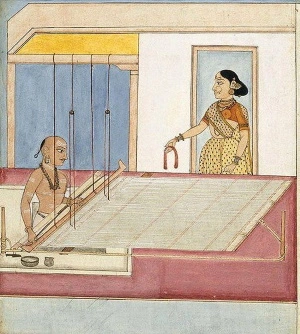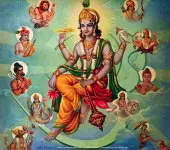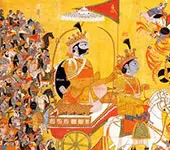Chaturvarnya Was Not A Caste System
Listen to the audio above

Transcript
(Click here to read more)
We have so far seen how Kadru the mother of serpents cursed her sons that they will burn to death at the sarpa-yajna to be conducted by Janamejaya. And also the birth of Astika who would stop the yajna mid-way and prevent the extermination of naga-vamsha. Some time back we also saw how Rishi Uttanka instigated Janamejaya to conduct the sarpa-yajna. Uttanka only instigated. But why should Janamejaya want to destroy the entire naga-vamsha. It was a revenge. Revenge for his father's killing by Takshaka. Janamejaya's father was Parikshit. Abh....
Transcript
(Click here)
We have so far seen how Kadru the mother of serpents cursed her sons that they will burn to death at the sarpa-yajna to be conducted by Janamejaya.
And also the birth of Astika who would stop the yajna mid-way and prevent the extermination of naga-vamsha.
Some time back we also saw how Rishi Uttanka instigated Janamejaya to conduct the sarpa-yajna.
Uttanka only instigated.
But why should Janamejaya want to destroy the entire naga-vamsha.
It was a revenge.
Revenge for his father's killing by Takshaka.
Janamejaya's father was Parikshit.
Abhimanyu's son.
Parikshit was a dharmatma.
He knew what dharma was.
Dharma of those times was varnashrama-dharma.
Division of the society into four varnas was based on guna and karma, nature and work.
Intellectuals would guide and teach.
Physically strong would protect society.
Another group will create wealth.
And the vast majority would do the execution of all kinds of work and support functions.
You take a corporate, a factory, a PSU, which is owned by people.
Say a manufacturing unit of fertilizers.
You will see the same structure there.
The first intellectuals: scientists, engineers who design the plant, fix production schedule, manage finances, do the planning; maybe 5 or 10 people.
The second group: security, those who protect the plant, even at the cyber level; maybe 50 or 100 people.
The third group: who go out and sell the products, generate revenue; maybe 50 or 100 people.
The vast majority say 2000 or 2500 people are engaged in regular work: production, maintenance, loading-unloading, transport, warehousing.
When you say chaturvarnya (Brahmana-Kshatriya-Vaishya-Shudra), it was similar.
Now, if this organization has to function successfully this structure has to be maintained.
Promotions happen.
People are hired, fired.
But the structure is maintained.
This is the duty of the king.
He should have the knowledge and capability to maintain the structure of the society.
Maintaining the structure is the dharma of the king.
Parikshit was a dharmatma.
He knew what was dharma and also knew how to enforce it.
Like how we have the Legislature, Executive, and the Judiciary today.
Legislature makes laws.
Executive implements those laws.
Judiciary ensures fair play and justice.
In the same way, the Executive and Judiciary were handled by kings.
Rule books ran down generations, of course with amendments from time to time in the form smritis and neeti-shastra.
Parikshit did his duty as king very well.
One peculiarity of Raja Parikshit was that he didn't have animosity towards anyone.
And nobody disliked him as well.
Everyone was content under his rule.
He took particular care in the welfare of widows, orphans, and the physically challenged.
In dhanurveda his guru was Kripcharya.
Do you know how he got the name Parikshit?
परिक्षीणेषु कुरुषु सोत्तरायामजीजनत्
When he took birth, the Kuru-vamsha was at its lowest ebb, it was pariksheena, weak.
He had only six enemies: kama, krodha, lobha, moha, mada, and matsarya
And he had conquered all of them.
His mind was under his control.
Mahabharata is praising him so much because we should not get a wrong idea about him.
We seem to think of him as an arrogant king who put a dead snake around a sage's neck.
No. It is not just that.
He was loved by everyone.
He was a good administrator.
Very intelligent.
He lived till the age of 60.
Now next we will see what caused his death.
Recommended for you
Stay Alert Stay Safe

In today’s world no amount of alertness is sufficient. You cannot afford to be absent minded. See, one mango fell into the river and it put the live....
Click here to know more..Interesting facts about Panchabhutas
 Click here to know more..
Click here to know more..
Anilatmaja Stuti

prasannamaanasam mudaa jitendriyam chatushkaram gadaadharam kri'tipriyam. vidam cha kesareesutam dri'd'havratam bhaje sadaa'nilaatmajam suraarchitam. ....
Click here to know more..
English Topics
Mahabharatam
Click on any topic to open
- 96 Two Curses That Worked against Karna
- 95 What is behind Calling the Five Brothers the Pandavas
- 94 Give up an Individual IF....
- 93 Fascinating Birth Story of the Kauravas
- 92 Overcoming Grief - Lessons from King Senajit's story
- 91 Yayati's Wisdom
- 90 Yayati's Story
- 89 Brahmacharis Can Bless And Curse
- 88 Human Nature - Comples Mix Of Good And Bad
- 87 Results Of Good Karma
Please wait while the audio list loads..
30
Ganapathy
Shiva
Hanuman
Devi
Vishnu Sahasranama
Mahabharatam
Practical Wisdom
Yoga Vasishta
Vedas
Rituals
Rare Topics
Devi Mahatmyam
Glory of Venkatesha
Shani Mahatmya
Story of Sri Yantra
Rudram Explained
Atharva Sheersha
Sri Suktam
Kathopanishad
Ramayana
Mystique
Mantra Shastra
Bharat Matha
Bhagavatam
Astrology
Temples
Spiritual books
Purana Stories
Festivals
Sages and Saints
